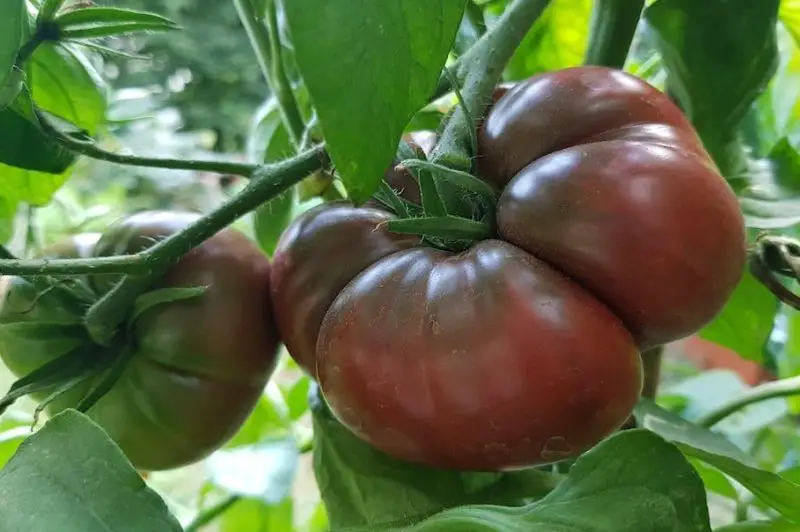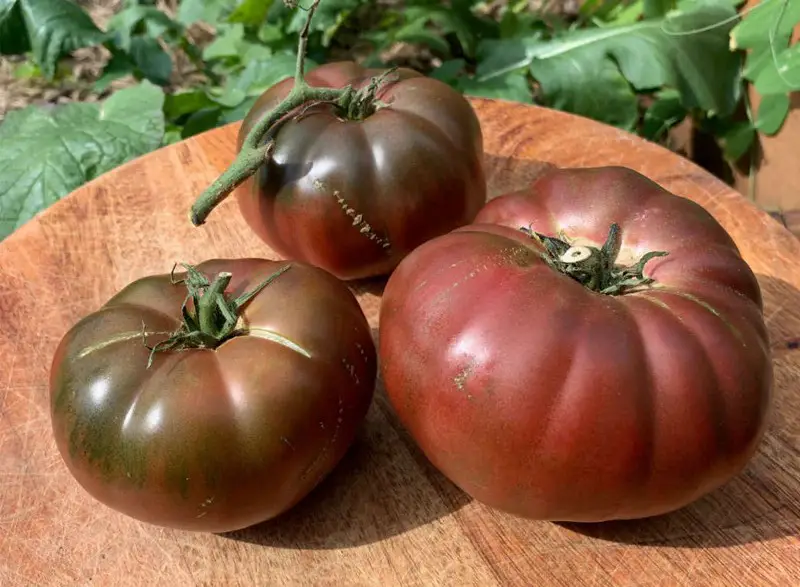The Black Krim tomato, with its striking dark maroon to nearly black fruit and rich, complex flavor, is a prized variety among tomato enthusiasts and gardeners. Originating from the Crimean peninsula, this heirloom tomato not only boasts a unique appearance but also requires specific care to thrive and produce a bountiful harvest.
In this comprehensive guide, we delve into the essential aspects of growing and caring for Black Krim tomatoes, including optimal planting times, site selection, and detailed care instructions.
Black Krim Tomato Overview

Medium-sized heirloom tomatoes called Black Krims have an eye-catching color spectrum that goes from dark maroon to deep purple to nearly black. This type stands out not just for its unusual color but also for its flattened globe form, squat shape, and peculiar flavor.
Black Krim tomatoes have a strong flavor that combines acidic and sweet undertones; they are sometimes described as having a hint of salt.
These tomatoes got their name from the Crimean peninsula, also known as “Krim” in Ukrainian, which is located on the Black Sea.
All parts of the tomato plant, except for the fruit, are toxic to humans and pets. Black Krim tomatoes belong to the Solanaceae family and are botanically known as Solanum lycopersicum ‘Black Krim’.
As an annual vegetable, the plant typically grows 4-6 feet tall with a spread of 3-4 feet. They thrive in full sun and well-drained, loamy soil with an acidic pH. Blooming in the summer, Black Krim tomatoes are suitable for hardiness zones 2-11 according to USDA guidelines.
Originating from Europe, these tomatoes bring a rich and complex flavor to any dish while connecting gardeners to the culinary traditions of the Crimean region.
How to Grow for Black Krim Tomatoes
When is the best time to plant Black Krim tomatoes?
Black Krim tomatoes are highly sensitive to cold, so it’s essential to plant them only after the danger of late spring frost has passed and the soil temperature has reached at least 60 degrees Fahrenheit.
To ensure successful transplantation, harden off the seedlings by gradually exposing them to outdoor conditions over a period of several days. This process involves placing the seedlings outside for a few hours each day, gradually increasing their time outdoors, and reducing their water intake to help them adjust to the change in environment.
This acclimation period helps the young plants become more resilient and better prepared for the transition from indoor or greenhouse conditions to the garden, ultimately promoting healthier growth and a more bountiful harvest.
Selecting a planting site for Black Krim tomatoes
Selecting the right planting site is crucial for the successful growth of Black Krim tomatoes, as they need abundant sunlight and heat to develop their rich color and flavor. Choose a location that receives full sun throughout the day and is free from the shade of surrounding plants or structures.
Additionally, ensure the site has excellent drainage to prevent waterlogging, which can harm the plants. If you lack a suitable spot in your garden, consider growing Black Krim tomatoes in large containers. This flexibility allows you to place the containers in optimally sunlit areas, ensuring your tomatoes receive the necessary light and warmth to thrive.
Additional Tips
When growing Black Krim tomatoes, it’s important to practice crop rotation to prevent soil-borne diseases. Never plant tomatoes in the same location where other members of the nightshade family, such as potatoes, eggplants, and peppers, were grown the year before.
These plants share similar susceptibilities to diseases and pests, which can persist in the soil and affect the new tomato crop. By rotating your crops and choosing a fresh planting site each year, you reduce the risk of disease buildup and promote healthier, more productive plants.
This practice is essential for maintaining soil health and ensuring a successful harvest season after season.
Black Krim Tomato Care Guide

Light
Black Krim tomatoes thrive best when they receive a minimum of six to eight hours of full sunlight each day. Adequate exposure to sunlight is crucial for their growth, as it helps the plants produce the energy needed for robust development and optimal fruit color.
A sunny location ensures that the tomatoes develop their characteristic dark, rich hues and enhances their overall flavor profile. When choosing a planting site, prioritize areas that are unobstructed by shading structures or surrounding plants to guarantee that the Black Krim tomatoes get the maximum amount of sunlight throughout the day.
Consistent and sufficient sunlight not only supports vigorous growth but also helps prevent issues such as weak stems and reduced fruit yield.
Soil
The soil for Black Krim tomatoes should be loamy, rich in organic matter, and well-drained to promote optimal growth. Loamy soil, which is a balanced mix of sand, silt, and clay, provides the perfect texture and structure for healthy root development and nutrient uptake.
Enriching the soil with organic matter, such as compost or well-rotted manure, enhances its fertility and improves moisture retention while ensuring excess water drains away efficiently. Black Krim tomatoes thrive in a slightly acidic environment with a pH range of 6.0 to 6.8. This pH level supports the availability of essential nutrients and fosters a healthy root system.
Before planting, it’s beneficial to test the soil’s pH and amend it if necessary to create the ideal growing conditions for these tomatoes, ensuring they reach their full potential in flavor and yield.
Water
Watering Black Krim tomatoes requires a deep and consistent approach to keep the soil consistently moist and prevent it from drying out. During hot summer conditions or for tomatoes grown in containers, daily watering may be necessary, and in extreme heat waves, you might need to water twice a day to maintain adequate moisture levels.
Insufficient water during the critical period of fruit development can lead to blossom end rot, a common problem caused by calcium deficiency linked to irregular watering. To effectively water your plants, apply water directly at the base of the plant rather than overhead. This method reduces the risk of fungal diseases, such as blight, which can spread when moisture is allowed to linger on the leaves and stems.
Ensuring the soil remains evenly moist without becoming waterlogged is key to promoting healthy growth and a bountiful harvest.
Temperature and Humidity
Black Krim tomatoes are well-suited to warm temperatures but are sensitive to cold, making timing crucial when planting. To ensure a successful growing season, plant them in the spring, once the weather has stabilized and the risk of frost has passed.
They thrive in the heat, but excessive humidity can create a favorable environment for fungal diseases, which can adversely affect plant health. To combat high humidity and reduce the risk of fungal infections, it’s important to maintain good air circulation around the plants. Regular pruning helps by removing excess foliage that can trap moisture and inhibit airflow.
Additionally, provide ample spacing between plants to further enhance air circulation and prevent moisture from accumulating on the leaves.
Fertilizer
To ensure optimal growth and fruit production for Black Krim tomatoes, use a general slow-release organic fertilizer designed for vegetables or a specialized tomato fertilizer that contains slightly higher levels of potassium. Potassium is crucial for fruit development and overall plant health.
Additionally, incorporating calcium into the soil can help prevent blossom end rot, a common issue caused by calcium deficiency. Follow the label instructions for the precise amount of fertilizer to use. At planting time, mix the fertilizer thoroughly into the soil to provide a strong nutrient foundation.
After the initial application, continue to fertilize every 2 to 3 weeks from May through August to sustain plant vigor and productivity. When applying fertilizer, ensure it is placed at least 3 inches away from the stem to avoid direct contact, which can harm the plant. Water the fertilizer thoroughly to help it dissolve and be absorbed by the roots.
Pollination
Black Krim tomatoes are predominantly self-pollinating, meaning they have the ability to produce fruit without relying on pollinating insects. This characteristic ensures that the plants can effectively set fruit even in the absence of external pollinators.
However, because Black Krim tomatoes are open-pollinated, they have the potential to cross-pollinate with other nearby tomato varieties. While this cross-pollination won’t impact the current season’s fruit, it can lead to a mix of genetic traits if you plan to save seeds for future planting.
To minimize the risk of cross-pollination and preserve the purity of the Black Krim variety, it is advisable to plant different heirloom tomato varieties at least 10 feet apart. This distance reduces the likelihood of pollen transfer between varieties, helping to maintain the distinct characteristics of each tomato type.
Harvesting
Harvesting Black Krim tomatoes can be somewhat tricky due to their unique ripening characteristics. The shoulders, or the area around the stem, may retain an olive-green or greenish hue even when the fruit is fully ripe. To accurately determine ripeness, focus on the overall color of the tomato rather than the shoulders.
A ripe Black Krim tomato should exhibit a deep, dark brown-red to almost black hue with a smooth, waxy skin. The color of the fruit should be uniformly rich and dark, indicating that it has developed its full flavor and sweetness. Avoid picking the tomatoes too early; they should be firm but slightly yielding to gentle pressure.
By observing the overall color and texture, you ensure that the Black Krim tomatoes are harvested at their peak flavor and quality.
Common Pests & Plant Diseases
Black Krim tomatoes can face several common pests and plant diseases that affect their growth and fruit quality. One frequent issue is cracking, which occurs when the fruit experiences rapid fluctuations in moisture levels, often due to inconsistent watering practices. To prevent cracking, maintain a consistent watering schedule and ensure the soil remains evenly moist.
Blossom end rot is another problem, typically caused by a calcium deficiency linked to irregular watering. Ensuring consistent moisture and providing adequate calcium can help mitigate this issue.
Additionally, Black Krim tomatoes are susceptible to fungal diseases such as Fusarium wilt and Verticillium wilt. These diseases affect the plant’s vascular system, leading to wilting, yellowing of leaves, and reduced fruit yield. To combat these fungal diseases, practice crop rotation, use disease-resistant varieties if available, and avoid overhead watering to reduce moisture on the foliage.
Proper plant care and preventative measures are essential for minimizing these issues and promoting healthy, productive tomato plants.






